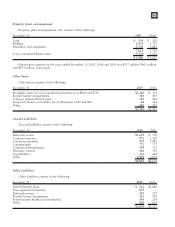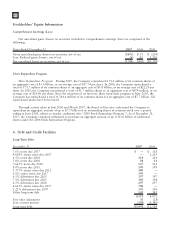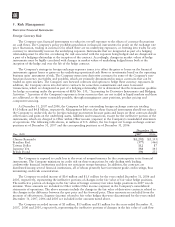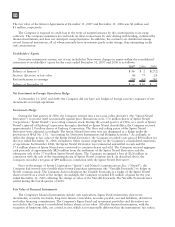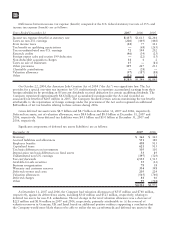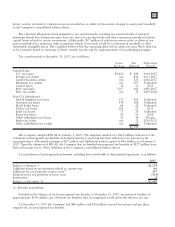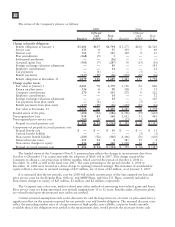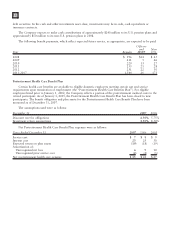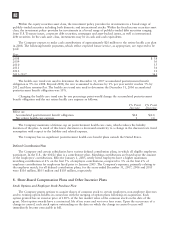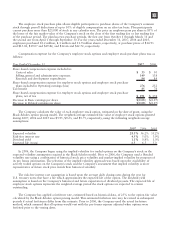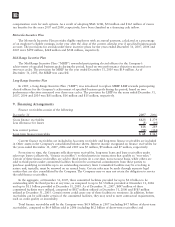Motorola 2007 Annual Report Download - page 106
Download and view the complete annual report
Please find page 106 of the 2007 Motorola annual report below. You can navigate through the pages in the report by either clicking on the pages listed below, or by using the keyword search tool below to find specific information within the annual report.
A summary of open tax years by major jurisdiction is presented below:
Jurisdiction:
United States
(1)
1996—2007
Brazil 2003—2007
China 1998—2007
France 2004—2007
Germany
(1)
2002—2007
India 1995—2007
Israel 2004—2007
Japan 2002—2007
Malaysia 1997—2007
Singapore 1998—2007
United Kingdom 1998—2007
(1) Includes federal as well as state, provincial or similar local jurisdictions, as applicable.
The Company is currently contesting significant tax adjustments related to transfer pricing for the 1996
through 2003 tax years at the appellate level of the Internal Revenue Service (“IRS”). The Company disagrees with
all of these proposed transfer pricing-related adjustments and intends to vigorously dispute them through
applicable IRS and judicial procedures, as appropriate. However, if the IRS were to ultimately prevail on these
matters, it could result in: (i) additional taxable income for the years 1996 through 2000 of approximately
$1.4 billion, which could result in additional income tax liability for the Company of approximately $500 million,
and (ii) additional taxable income for the years 2001 and 2002 of approximately $800 million, which could result
in additional income tax liability for the Company of approximately $300 million. The IRS is currently reviewing
a claim for additional research tax credits for the years 1996-2003. The IRS is conducting its field examination of
the Company’s 2004 and 2005 tax returns. Although the final resolution of these matters is uncertain, based on
current information, in the opinion of the Company’s management, the ultimate disposition of these matters will
not have a material adverse effect on the Company’s consolidated financial position, liquidity or results of
operations. However, an unfavorable resolution could have a material adverse effect on the Company’s
consolidated financial position, liquidity or results of operations in the periods in which the matter is ultimately
resolved. It is reasonably possible that within the next 12 months, these disputes will be resolved and such
resolution may have a significant impact upon the amount of unrecognized tax benefits related to these issues.
The Company has several other non-U.S. income tax audits pending and while the final resolution is
uncertain, in the opinion of the Company’s management, the ultimate disposition of the audits will not have a
material adverse effect on the Company’s consolidated financial position, liquidity or results of operations.
Based on the outcome of these examinations, or as a result of the expiration of statute of limitations for
specific jurisdictions, it is reasonably possible that the related unrecognized tax benefits for tax positions taken
regarding previously filed tax returns will differ from those recorded as liabilities in the Company’s consolidated
balance sheets at December 31, 2007. The Company anticipates that it is reasonably possible that within the next
12 months, several of the audits may be finalized resulting in a reduction in unrecognized tax benefits of
approximately $40 million. However, based on the number of tax years currently under audit by the relevant
federal, state and foreign tax authorities, the status of these examinations, and the protocol of finalizing audits by
the relevant tax authorities, which could include formal legal proceedings, it is not possible to estimate the impact
of any other amounts of such changes, if any, to previously recorded uncertain tax positions.
7. Retirement Benefits
Pension Benefit Plans
The Company’s noncontributory pension plan (the “Regular Pension Plan”) covers U.S. employees who
became eligible after one year of service. The benefit formula is dependent upon employee earnings and years of
service. Effective January 1, 2005, newly-hired employees were not eligible to participate in the Regular Pension
Plan. The Company also provides defined benefit plans which cover non-U.S. employees in certain jurisdictions
principally the United Kingdom, Germany, Ireland, Japan and Korea (the “Non-U.S. Plans”). Any other pension
plans are not material to the Company either individually or in the aggregate.
The Company has a noncontributory supplemental retirement benefit plan (the “Officers’ Plan”) for its
officers elected prior to December 31, 1999. The Officers’ Plan contains provisions for vesting and funding the
98



